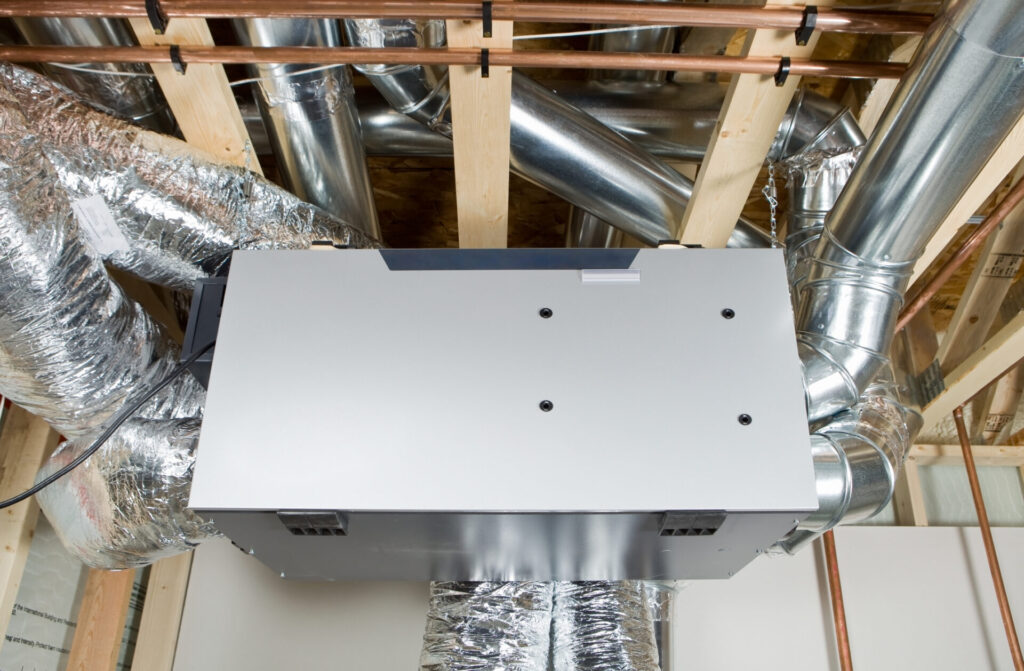What is the purpose of air exchangers? They improve indoor air quality by controlling humidity and reducing pollutants and bad odours thereby creating a healthier and more comfortable living space. Good ventilation can help diminish allergies, respiratory infections and mould growth.
How do they work? “Air exchangers consist of either a heat recovery ventilator (HRV) or an energy recovery ventilator (ERV), fitted inside a casing with two independent duct networks, each with its own intake and exhaust ports,” explains Yanick Blouin, President of Ventilation Venstat. The first duct network collects and evacuates stale air from the house to the outside, while the second simultaneously draws in fresh air from the outside, filtering then circulating it through vents into every room of the house.”
But to get the maximum benefit from an air exchanger, its proper use is imperative. “Ventilation requirements vary depending as much on the number of occupants and their particular needs as on the season and weather conditions outside,” says Blouin. “For example, the HRV should be activated when the outside temperature is colder than inside, but it shouldn’t be used during the summer months as it will introduce humid air. On the other hand, if it’s hot and humid outdoors, the device’s recirculation mode may help distribute fresh air generated by the air conditioner inside the house.” It’s best to ask specialists about the correct operational procedures.
What’s the difference between HRVs and ERVs?
Heat recovery ventilators (HRVs) capture part of the heat from outgoing stale air and use it to preheat incoming fresh air, thereby providing ventilation without too much heat loss during the winter months. Energy recovery ventilators (ERVs) exchange heat to a lesser extent than HRVs, but they also transfer moisture between incoming and outgoing air. This quality makes them adept at controlling humidity levels in the house.
How do you choose the right air exchanger?
According to Blouin, an air exchanger’s capacity is mainly determined by the home’s square footage. “The general range is between 100 and 150 CFMs (cubic feet per minute) depending on the area to be ventilated. Other criteria to consider are the heat recovery rate, motor performance and duct networks. For example, the longer the ducts run, the more powerful the device must be to ensure adequate air circulation.” It’s best to deal with a reputable company for sound advice.

How much does it cost?
Pricing depends on the scope of the work. A ballpark figure for purchasing and installing an air exchanger in an existing 2,500-square-foot residence is between $2,500 and $3,500.
What’s the impact of air exchangers on energy consumption?
According to the independent organization Ecohome, HRVs reduce heating costs by transferring part of the heat from outgoing stale air to incoming fresh air. At -25°C outside, for example, an efficient model can recover a whopping 60 to 80 percent of the heat. ERVs, too, perform their energy-saving part. “With balanced humidity levels, heating and cooling systems don’t have to work so hard, and you’ll see lower energy-consumption bills,” says Blouin. That being said, to save the most energy, ensure proper installation, follow the instructions for proper use and service your system on a regular basis.
How to maintain a ventilation system?
To guarantee optimal performance, the system must be maintained every three months. Consult the manufacturer’s manual for maintenance planning and scheduling periods to determine how to proceed. You should clean the HRV or ERV with soapy water, wash the inside of the casing with a damp cloth and inspect the intake and exhaust vents to ensure they’re not obstructed by debris. Ventilation ducts should be professionally cleaned every five years. Of course, the frequency of these procedures can vary depending on the number of occupants and their habits. For example, the presence of pets, smokers or asthma sufferers could require more frequent maintenance.
Get an air exchanger for your home
When purchasing an air exchanger online from Rona, Members earn 2% back in CAA Dollars.


